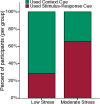Low lifetime stress exposure is associated with reduced stimulus-response memory
- PMID: 28298555
- PMCID: PMC5362698
- DOI: 10.1101/lm.045179.117
Low lifetime stress exposure is associated with reduced stimulus-response memory
Abstract
Exposure to stress throughout life can cumulatively influence later health, even among young adults. The negative effects of high cumulative stress exposure are well-known, and a shift from episodic to stimulus-response memory has been proposed to underlie forms of psychopathology that are related to high lifetime stress. At the other extreme, effects of very low stress exposure are mixed, with some studies reporting that low stress leads to better outcomes, while others demonstrate that low stress is associated with diminished resilience and negative outcomes. However, the influence of very low lifetime stress exposure on episodic and stimulus-response memory is unknown. Here we use a lifetime stress assessment system (STRAIN) to assess cumulative lifetime stress exposure and measure memory performance in young adults reporting very low and moderate levels of lifetime stress exposure. Relative to moderate levels of stress, very low levels of lifetime stress were associated with reduced use and retention (24 h later) of stimulus-response (SR) associations, and a higher likelihood of using context memory. Further, computational modeling revealed that participants with low levels of stress exhibited worse expression of memory for SR associations than those with moderate stress. These results demonstrate that very low levels of stress exposure can have negative effects on cognition.
© 2017 Goldfarb et al.; Published by Cold Spring Harbor Laboratory Press.
Figures




Similar articles
-
Cumulative lifetime stressor exposure impairs stimulus-response but not contextual learning.Sci Rep. 2024 Jun 7;14(1):13080. doi: 10.1038/s41598-024-62595-x. Sci Rep. 2024. PMID: 38844465 Free PMC article.
-
Acute Stress Time-dependently Modulates Multiple Memory Systems.J Cogn Neurosci. 2017 Nov;29(11):1877-1894. doi: 10.1162/jocn_a_01167. Epub 2017 Jul 12. J Cogn Neurosci. 2017. PMID: 28699809
-
Determining the mechanisms through which recent life stress predicts working memory impairments: precision or capacity?Stress. 2019 Mar;22(2):280-285. doi: 10.1080/10253890.2018.1556635. Epub 2019 Feb 15. Stress. 2019. PMID: 30767585 Free PMC article.
-
Learning under stress: a role for the neural cell adhesion molecule NCAM.Neurobiol Learn Mem. 2009 May;91(4):333-42. doi: 10.1016/j.nlm.2008.11.003. Epub 2008 Dec 18. Neurobiol Learn Mem. 2009. PMID: 19041949 Review.
-
Sex differences in stress effects on emotional learning.J Neurosci Res. 2017 Jan 2;95(1-2):93-105. doi: 10.1002/jnr.23811. J Neurosci Res. 2017. PMID: 27870431 Review.
Cited by
-
Lifecourse Traumatic Events and Cognitive Aging in the Health and Retirement Study.Am J Prev Med. 2022 Nov;63(5):818-826. doi: 10.1016/j.amepre.2022.05.007. Epub 2022 Jul 5. Am J Prev Med. 2022. PMID: 35798618 Free PMC article.
-
Cumulative lifetime stressor exposure assessed by the STRAIN predicts economic ambiguity aversion.Nat Commun. 2022 Mar 30;13(1):1686. doi: 10.1038/s41467-022-28530-2. Nat Commun. 2022. PMID: 35354811 Free PMC article.
-
Memory biases in alcohol use disorder: enhanced memory for contexts associated with alcohol prospectively predicts alcohol use outcomes.Neuropsychopharmacology. 2020 Jul;45(8):1297-1305. doi: 10.1038/s41386-020-0650-y. Epub 2020 Mar 3. Neuropsychopharmacology. 2020. PMID: 32126569 Free PMC article.
-
Cumulative lifetime stressor exposure impairs stimulus-response but not contextual learning.Sci Rep. 2024 Jun 7;14(1):13080. doi: 10.1038/s41598-024-62595-x. Sci Rep. 2024. PMID: 38844465 Free PMC article.
-
Threat-induced modulation of hippocampal and striatal memory systems during navigation of a virtual environment.Neurobiol Learn Mem. 2020 Feb;168:107160. doi: 10.1016/j.nlm.2020.107160. Epub 2020 Jan 7. Neurobiol Learn Mem. 2020. PMID: 31918021 Free PMC article.
References
-
- Anders SL, Frazier PA, Shallcross SL. 2012. Prevalence and effects of life event exposure among undergraduate and community college students. J Couns Psychol 59: 449–457. - PubMed
-
- Breslau N, Davis GC, Andreski P, Peterson E. 1991. Traumatic events and posttraumatic stress disorder in an urban population of young adults. Arch Gen Psychiatry 48: 216–222. - PubMed
Publication types
MeSH terms
Grants and funding
LinkOut - more resources
Full Text Sources
Other Literature Sources
Medical
Research Materials
